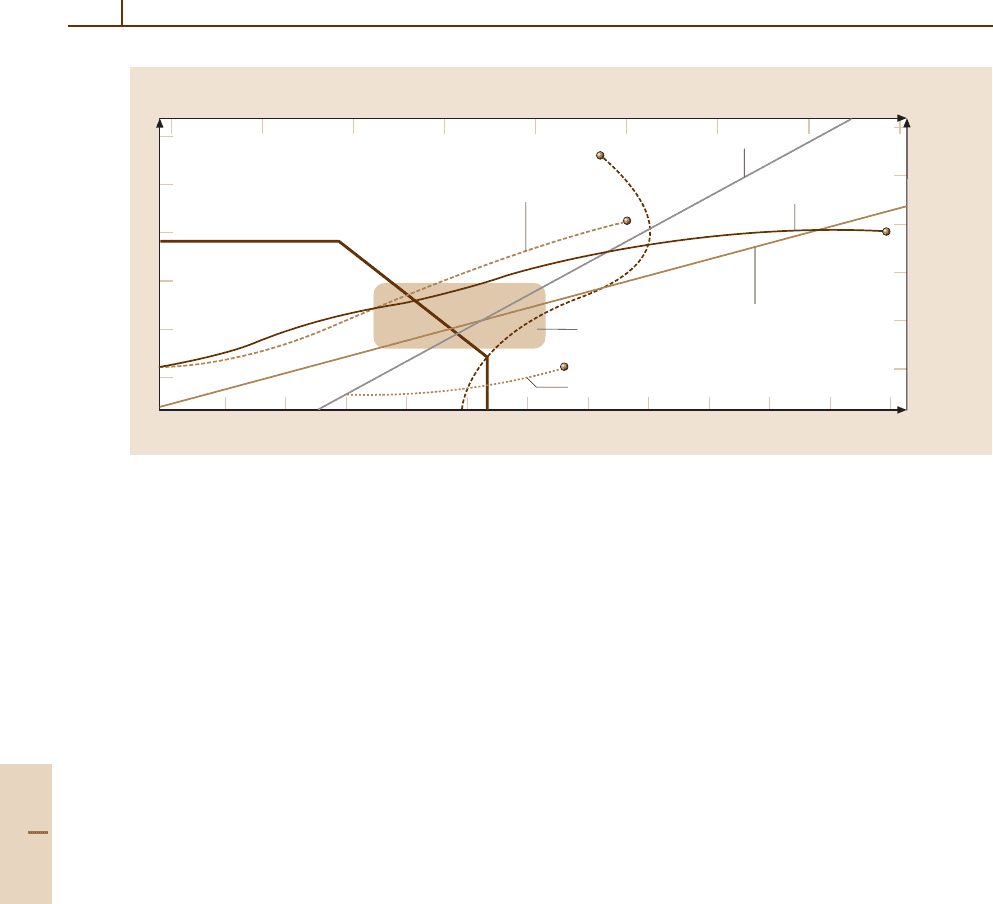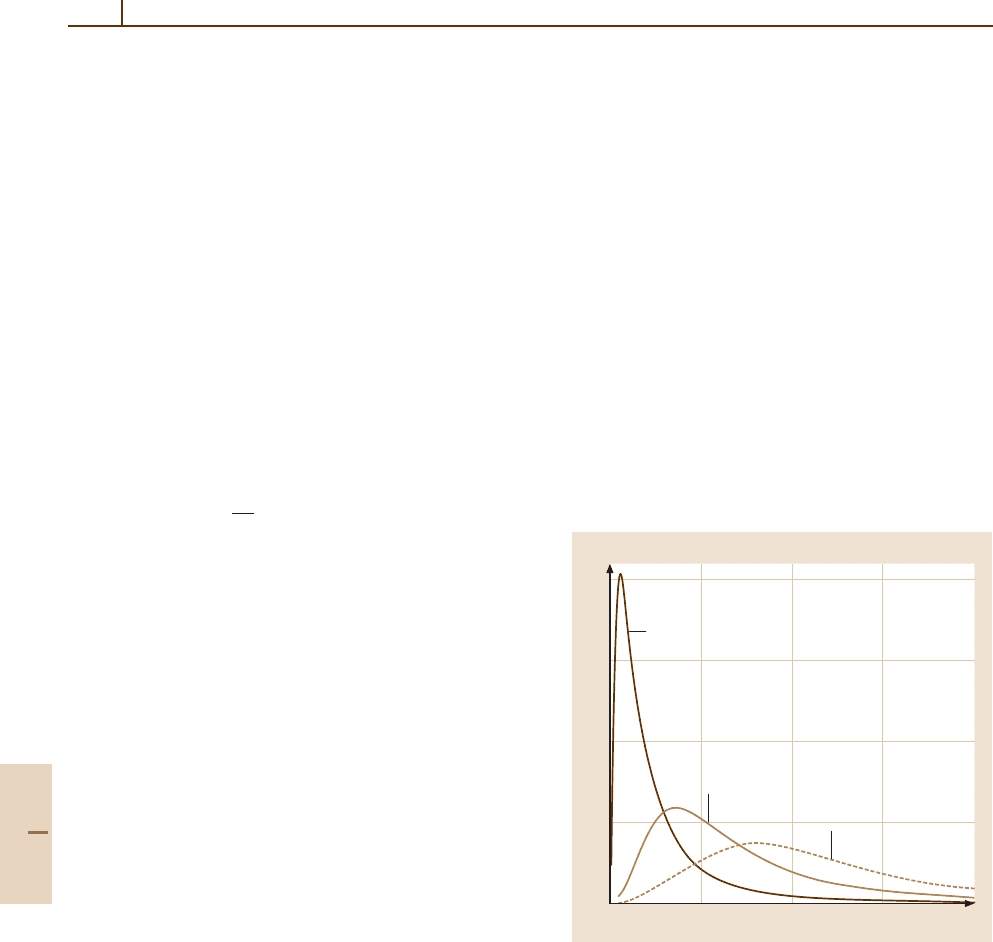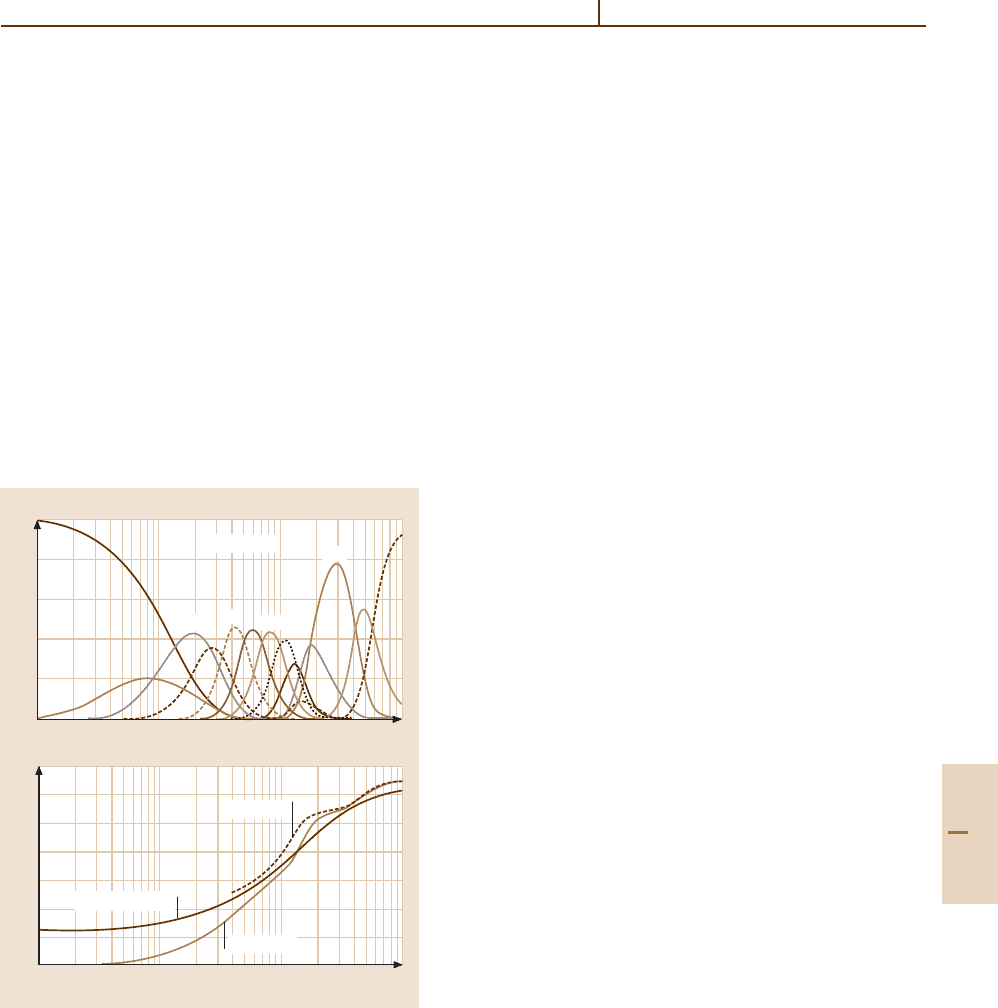Drake G.W.F. (editor) Handbook of Atomic, Molecular, and Optical Physics
Подождите немного. Документ загружается.


1303
Atoms in Dens
86. Atoms in Dense Plasmas
When plasma densities are high enough that inter-
particle separations are comparable to atomic
dimensions, there are important “environmental”
consequences for atomic structure and atomic
processes. Such conditions are found not only
within stars and giant planets but, nowadays,
also in the laboratory – especially in experiments
related to the quest for inertial confinement
fusion. After introducing important plasma
concepts, we examine these consequences in
regard to several issues: modification of atomic
bound states, ionization balance, equation of
state, and radiative and collisional processes
that regulate transport coefficients and the
spectral emission of non-equilibrium plasmas.
Finally, we describe modern simulation methods
that are being used to tackle various many-
body problems in this subject. For nearly
every issue we raise there is a need for better
86.1 The Dense Plasma Environment ............1305
86.1.1 Plasma Parameters....................1305
86.1.2 Quasi-Static Fields in Plasmas..... 1305
86.1.3 Coulomb Logarithms
and Collision Frequencies...........1307
86.2 Atomic Models and Ionization Balance ..1308
86.2.1 Dilute Plasma Models ................ 1308
86.2.2 Dense Plasma “Chemical” Models1309
86.2.3 Dense Plasma “Physical” Models. 1310
86.3 Elementary Processes ...........................1311
86.3.1 Radiative Transitions and Opacity 1311
86.3.2 Collisional Transitions ................1312
86.4 Simulations.........................................1313
86.4.1 Monte Carlo..............................1313
86.4.2 Molecular Dynamics...................1313
86.4.3 The Deuterium EOS Problem........1315
References .................................................. 1316
understanding and for more, and more precise,
data.
Ionized gases, or plasmas, are the predominant form of
matter throughout the universe, and physical conditions
in laboratory and cosmic plasmas vary greatly. No sin-
gle experimental methodology or theoretical construct
suffices to explore all aspects of the plasma state.
Systematic study of plasmas began early in the 20
th
century, but until recently the physics of atoms in plas-
mas has been largely synonymous with the physics of
isolated ions. This perspective is valid as long as the in-
terparticle spacing is very much larger than the relevant
atomic dimensions, typically a few to a few tens of Bohr
radii. For example, ions are isolated in this sense in inter-
stellar space where the electron density n
e
≈ 1cm
−3
,or
even in a tokamak, where n
e
≈ 10
14
cm
−3
. For neutral
and moderately charged atoms, data such as energy lev-
els, oscillator strengths, and collision cross sections have
long been obtained from traditional kinds of experiments
and quantal calculations, as discussed elsewhere in this
book. Progress in these areas continues to be made, with
the X-ray spectrum of highly-charged Fe [86.1]andthe
Lamb shift in U
+91
[86.2] being noteworthy examples
of the kinds of accurate measurements that can now be
made using electron beam ion traps and storage rings.
The focus of the present chapter is partially ionized
matter in which important atomic phenomena are in-
fluenced by a dense plasma environment. As Fig. 86.1
(which is discussed in detail below) reveals, the densi-
ties in many laboratory and astrophysical plasmas are
high enough to invalidate the presumption of isolated
systems. The interaction of intense laser or particle
beams with solid matter produces rapidly evolving, hot,
and dense plasmas [86.3] that mimic some of the most
extreme conditions in nature, including the thermonu-
clear environment of stellar interiors; these plasmas, as
well as some produced in z-pinch implosions [86.4],
are the basis of world-wide inertial confinement fu-
sion (ICF) efforts. Dense plasmas also can be transient
gain media for amplified spontaneous emission at X-ray
wavelengths [86.5]. Additional impetus for the study
of atoms in dense plasmas now comes from exper-
iments involving irradiation of solids by ultra-short
(sub-picosecond) laser pulses [86.6]. The moderate tem-
peratures (tens of eV) but high (near-solid) densities
typical of this so-called warm dense matter (WDM)
regime [86.7] produce severely perturbed bound ionic
states.
Part G 86

1304 Part G Applications
9
8
7
6
5
4
210–1–2
5
4
3
2
1
0
18 21 24 27 30
log[T
e
(K)] log[R
e
(a
0
)]
log[Θ
e
(eV)]
log[n
e
(cm
–3
)]
P
= 1 Mbar
NIF main fuel
Sun
Jupiter
White dwarf
Warm dense
matter
Γ
ee
= 1
= 1
Υ
Fig. 86.1 Plasma conditions discussed in the text are identified on this temperature-density plane. Plasmas below the line
Γ
ee
= 1 are strongly coupled, and those below the line Υ = 1 contain degenerate electrons. The HEDP regime, which
lies above and to the right of the line marked P = 1 Mbar, includes some conditions characteristic of warm dense matter.
Also plotted are tracks representing conditions (as a function of radius) within the Sun, Jupiter and a typical white dwarf
star; time-dependent conditions are also shown – from early compression through ignition – within the main (DT) fuel of
a prototype target capsule for the National Ignition Facility
Dense cosmic plasmas – specifically, the interiors of
stars and giant planets – are very large and have very long
lifetimes. Their thermodynamic variables change only
slowly with position or time and, hence, macroscopic
regions can be considered as statistical systems evolving
through a succession of states in local thermodynamic
equilibrium (LT E). The equation of state (EOS), and the
radiation and heat transport coefficients, viz. the opacity
and thermal conductivity, are key to understanding the
behavior of LTE plasmas. A recent monograph [86.8],
plus comprehensive articles by More et al. [86.9], by
Rogersand Iglesias[86.10], and by Saumonet al. [86.11]
discuss many of the high density consequences for the
opacity and for EOS.
In contrast, the short lifetimes of dense plasmas cre-
ated by intense beam irradiation or by explosive pinch
devices often preclude the establishment of a thermal
distribution of atomic level populations; in extreme
cases, there is not even enough time to establish
a Maxwellian distribution of particle velocities. Pop-
ulations in highly nonequilibrium (non-LTE) laboratory
plasmas, which must be found by solving rate equa-
tions [86.12, 13], are essential information for using
X-ray line emission to diagnose conditions in ICF tar-
gets, or for identifying likely gain media for X-ray
lasing. And, as we discuss in Sect. 86.3, the dense
plasma environment modifies transition rates them-
selves, further complicating the interplay of numerous
collisional and radiative processes in such atomic kinet-
ics calculations.
The topics addressed here are needed for under-
standing non-LTE situations, as well as LTE ones. After
characterizing the perturbing plasma environment in
Sect. 86.1, we summarize well-known prescriptions for
atomic structure and ionization balance in Sect. 86.2,and
then discuss modified transition rates in Sect. 86.3 for
ions in dense plasmas. Finally, we review in Sect. 86.4
how simulations are now being used to address a wide
array of issues needed to accurately describe atoms in
dense plasmas.
There are several periodic meetings devoted to vari-
ous aspects of this subject, and especially relevant ones
include: Atomic Processes in Plasmas; Radiative Prop-
erties of Hot, Dense Matter; Spectral Line Shapes; and
Strongly Coupled Coulomb Systems. Printed proceed-
ings of these conferences are an excellent guide to recent
developments in the topics discussed here, as well as
numerous other, related ones. Additionally, three re-
cent textbooks [86.14–16] provide detailed treatments
of many of the subjects surveyed here.
The present topic is an important part of what
is now being termed “high energy-density physics”
Part G 86

Atoms in Dense Plasmas 86.1 The Dense Plasma Environment 1305
(HEDP). Conventionally this interdisciplinary subject,
which involves collective and/or non-linear phenomena
in many-body systems, is defined as the study of matter
in regimes where the total (matter plus electromagnetic
field) pressure exceeds one megabar; this boundary is
also marked in Fig. 86.1. Reference [86.17]isare-
cent National Research Council report on key issues
and opportunities in HEDP.
86.1 The Dense Plasma Environment
Most plasmas are charge neutral, so the mean number
densities n
i
and n
e
of constituent ions (charge Z
i
e,mass
m
i
) and electrons (charge −e,massm
e
) satisfy
a
Z
a
n
a
= 0 , (86.1)
where the sum ranges over all particle species. Moreover,
plasma conditions usually change slowly enough that
each of the species is able to establish a thermal distri-
bution of velocities, fixed by its temperature Θ
a
= k
B
T
a
(in energy units). Here, we assume these conditions hold.
86.1.1 Plasma Parameters
A few key quantities characterize the plasmas under
consideration. Derivations, and discussions of the roles
of these and other auxiliary quantities can be found in
standard plasma physics texts [86.18, 19], as well as
a recent tutorial article [86.20].
1. The plasma frequency
ω
p
=
a
4πn
a
(Z
a
e)
2
/m
a
1/2
=
a
ω
2
a
1/2
(86.2)
defines a timescale
∼ ω
−1
e
for the particle oscilla-
tions in response to a non-equilibrium charge density
in the plasma.
2. The Debye length
λ
D
=
a
4πn
a
(Z
a
e)
2
/Θ
a
−1/2
=
a
D
−2
a
−1/2
(86.3)
is the distance beyond which plasma particles effec-
tively screen any localized charge imbalance.
3. The ion-sphere (or electron-sphere) radius
R
a
=
3
4πn
a
1/3
(86.4)
defines a spherical volume associated with a single
particle and is a measure of interparticle spacing
(among particles of species “a”).
4. The Fermi energy
Θ
F
=
2
3π
2
n
e
2/3
2m
e
(86.5)
characterizes the highest occupied energy level in
a zero temperature system of electrons. A dimen-
sionless measure of degeneracy is Υ = Θ
F
/Θ
e
.
Velocity distributions are either Maxwellian or
Fermi–Dirac in the limits Υ 1orΥ 1,
respectively.
5. The Coulomb coupling parameters
Γ
ab
=
Z
a
Z
b
e
2
R
ab
Θ
ab
(86.6)
give the average ratio of potential to kinetic en-
ergies between species a and b. The reduced
ion-sphere radius and temperature are R
ab
=
1
2
(R
a
+
R
b
) and Θ
ab
=(m
a
Θ
b
+m
b
Θ
a
)/(m
a
+m
b
), respec-
tively. When Γ
ab
is greater (less) than 1, that species
is said to be strongly (weakly) coupled. And, when
the number of particles a in a sphere of radius D
a
(a Debye sphere),
4πn
a
D
3
a
/3
= 1/(3Γ
aa
)
3/2
,is
small, discreteness of the charge density can be
important in describing certain plasma phenomena.
Figure 86.1 shows that dense plasmas can be strongly
or weakly coupled; further, some of these plasma condi-
tions involve degenerate electrons while others do not.
And, in WDM, one encounters the situation where Υ ∼1
and Γ
ee
∼ 1, which is particularly difficult to treat theo-
retically because several effects are competing amongst
each other. In this figure, we plot the run of (n
e
, Θ
e
)
values for the sun, for Jupiter, and for a typical white
dwarf star (0.6 solar mass, pure C/O core, H/He outer
layers). Also plotted is the track of DT fuel conditions
in an imploding ICF capsule designed for the National
Ignition Facility. Note that all of these systems sample
wide portions of parameter space, and therefore an ac-
curate description of each requires some very different
plasma models.
Part G 86.1

1306 Part G Applications
86.1.2 Quasi-Static Fields in Plasmas
A simple, yet useful description of the plasma en-
vironment is given by the one-component plasma
(OCP) model [86.22], in which particles of a single
kind (Z
a
,m
a
) move against a smooth background of
matter having on average the opposite charge den-
sity, ρ(r) =−Z
a
en
a
. Most plasma phenomena can be
described within the context of either this or the two-
component model (electrons and their parent ions, with
n
i
= n
e
/Z
i
). In the more realistic, two-component pic-
ture, electron screening of the (slower moving) ions is
established on a timescale ω
−1
e
ω
−1
i
, so it makes sense
to speak of screened, quasi-static ionic fields.
When there are many electrons in each Debye
sphere, the electrostatic potential Φ(r) near a test charge
Ze placed in an otherwise uniform, neutral plasma is
exponentially reduced from the Coulomb expression,
viz.,
Φ
D
(r) =
Ze
r
exp
(
−r/D
e
)
.
(86.7)
(A more elaborate version of this formula, for partially
ionized atoms, has recently been proposed [86.23].) This
“Debye screening” obtains only in weakly coupled plas-
mas and applies only to a test charge at rest. The faster
the charge Ze moves, the less effective is the plasma
at screening it, since only plasma particles with higher
velocities can form the shielding cloud [86.18, 24].
In the opposite limit of large Γ -values, quasi-static
screening is better described by the ion-sphere (IS) pic-
ture [86.19], in which each stationary ion of charge
Z
i
e is surrounded by Z
i
electrons, uniformly distributed
throughout a sphere of radius R
i
, to produce the potential
Φ
IS
(r) = Z
i
e
1/r −(1/2R
i
)
3 −r
2
/R
2
i
(86.8)
inside the sphere, and zero potential outside.
Consideration of a plasma’s electric microfield illus-
trates these concepts. Moreover, microfields are a key
ingredient in calculations of spectral line broadening in
plasmas – an important subject discussed in Chapts. 59,
19 and in [86.14–16].
Local fluctuations in the density of any species about
its mean value n
a
create a microscopic electric field
˜
E
a
(r, t). There is a probability distribution P(
˜
E
a
) that
characterizes the strengths of these microfields, which
are quasi-static within time intervals short compared
with the fluctuation timescale, 1/ω
i
. Holtsmark first cal-
culated this distribution at an arbitrary position in an
infinite, isotropic gas of noninteracting particles, and
Chandrasekhar [86.25] gives a thorough account of this
famous stochastic problem. Holtsmark’s formula is
P
H
(ε) = (2ε/π)
∞
0
x sin(εx) exp
−x
3/2
dx ,
(86.9)
where ε =
˜
E
a
/
(8π/25)
1/3
E
a
is the scaled field, and
E
a
=|Z
a
|e/R
2
a
. The mean Holtsmark field is ε2.99,
and for ε 1, P
H
(ε) is well approximated by the distri-
bution of fields due to a single nearest-neighbor in the
gas,
P
nn
(ε) 3/
2ε
5/2
.
(86.10)
Both of these distributions ignore the interactions among
charged particles that become increasingly important
as Γ
ii
grows, because particle positions then tend to
be correlated. Quasi-static ion microfields – at the
position of an ion – therefore become weaker, on av-
erage, as the coupling increases. Figure 86.2 illustrates
this point and shows distributions computed with the
2.0
1.5
1.0
0.5
0.0
0123 4
ε
P( )
ε
Γ = 2.0
Γ = 0.2
H
Fig. 86.2 The probability distribution P(ε) of scaled mi-
crofield strengths ε for different plasma conditions. The
curve marked H represents the Holtsmark distribution,
which applies to an idealized case of non-interacting par-
ticles (i. e., Γ = 0). The other two curves, with Γ = 0.2
and Γ = 2.0, represent distributions determined by the
APEX model for interacting ions (charge Z = 1) that
are Debye-screened by plasma electrons. In these latter
two cases, the ion density and temperature are, respec-
tively, 1.0×10
18
cm
−3
and 1.15 eV, and 2.6×10
24
cm
−3
and 16 eV. After [86.21]
Part G 86.1

Atoms in Dense Plasmas 86.1 The Dense Plasma Environment 1307
APEX method [86.26, 27], which uses a parameterized,
two-particle distribution function “tuned” to yield the
exact second moment
ε
2
for the distribution func-
tion of field strengths experienced by any one ion in
a plasma whose ions are all Debye-screened by electrons
only.
The potentials and microfields discussed above are
based on classical statistical mechanics, even though
dense plasmas are inherently quantum many-body sys-
tems. Reference [86.28] provides a careful discussion of
the merits and limitations of this approach.
86.1.3 Coulomb Logarithms
and Collision Frequencies
It is well known that the total cross section for
elastic scattering of two charged particles, Z
a
e and
Z
b
e, diverges at any collision energy E ,asaconse-
quence of the infinite range of the Coulomb interaction.
Plasma transport coefficients (e.g., electrical con-
ductivity and thermal conductivity), however, which
depend ultimately upon momentum transfer in this
elementary process, are finite. This comes about be-
cause scattering at small center-of-mass angles φ,
or, correspondingly, at large impact parameters b,is
diminished by plasma screening, as in (86.7)and
(86.8).
Following Spitzer [86.29], we argue that there is
some minimum effective scattering angle φ
min
. And,
since the analysis will be based on classical formulae,
there is some maximum scattering angle φ
max
beyond
which quantum effects are important. Between these
limits the Coulomb interaction is taken to be unscreened
and Rutherford’s differential cross section σ
R
(φ) is ap-
plicable. By assuming that φ
max
also is small, it follows
that the momentum transfer cross section can be approx-
imated as
σ
m
(E ) = 2π
φ
max
φ
min
dφ
[
sin φ
(
1 −cos φ
)
σ
R
(φ)
]
≈ πa
2
ln
φ
max
φ
min
,
(86.11)
where a =
Z
a
Z
b
e
2
/E is a characteristic length. The
familiar result (a/2b) = tan(φ/2) ≈ (φ/2) gives σ
m
in
terms of minimum and maximum impact parameters,
b
min
= a (from φ
max
= 1) and b
max
= λ
D
.
Finally, if the actual collision energy in the argument
of the logarithm, (λ
D
/a), is replaced by its mean value,
E =
3
2
Θ, the momentum transfer cross section takes the
simple form
σ
m
(E ) = π
Z
a
Z
b
e
2
E
2
ln Λ ; (86.12)
for a two-component, electron-ion plasma, the argument
of this Coulomb logarithm is
Λ ≈ 1/2Γ
3/2
eZ
≈ (# particles in Debye sphere).
(86.13)
Spitzer’s result for σ
m
yields the simplest expression for
the frequency ν
eZ
of electron-ion collisions in a two-
component plasma, defined [86.18] as the mean value
of the reciprocal of the time between collisions,
ν
eZ
=
n
Z
Z
2
e
4
√
m
e
π
2Θ
3/2
ln Λ. (86.14)
Equation (86.12) is commonly used to determine trans-
port coefficients in weakly coupled plasmas, where
ln Λ 1. In the dense plasma regime, however, the
Coulomb logarithm can be small or even negative at
high enough density, which yields meaningless results
for the cross section. Physically, a small ln Λ arises
from a small λ
D
(high density and/or low tempera-
ture), which means that collisions can only occur at
very small separations where the Coulomb potential is
largest. Strong collisions can be included in the above
analysis simply by not making a small-angle approxi-
mation in the evaluation of the cross section; the result
is [86.30]
σ
m
(E ) =
π
2
Z
a
Z
b
e
2
E
2
ln
1 +Λ
2
.
(86.15)
In obtaining this result – which no longer yields a neg-
ative cross section – no assumption need be made
about the value of φ
max
. One must still choose, how-
ever, b
max
, which will not generally be given by λ
D
,
since Debye screening is invalid in the dense plasma
regime. Strong collisions at small separations also bring
in the effects of quantal scattering. These issues are
best circumvented by obtaining the cross section di-
rectly from a quantal calculation involving the chosen
screened potential [86.30, 31]. (Note that the formulae
in [86.31] actually describe the scattering of one un-
screened charge by another charge that is screened, so
they are most relevant to the scattering of fast electrons
by slow ions.)
Eventually, even this formulation will fail when
plasma kinetic processes affect the collision. For
example, hard collisions can alter the velocity dis-
tribution function and collective modes can modify
Part G 86.1

1308 Part G Applications
the static screened interaction potential. Furthermore,
strong coupling introduces ionic structure that corre-
lates the collisions. Accurate calculations must consider
the collision process in the context of an appro-
priate kinetic equation [86.30, 32–34]. When such
a process is carried out, the result can be inverted
to yield “effective” or “generalized” Coulomb loga-
rithms that typically are process dependent [86.18].
Li and Petrasso [86.32] obtained high-order cor-
rection terms for the Fokker–Planck equation, for
example, and Boercker et al. [86.33] generalized the
collision term in the Lenard–Balescu quantum ki-
netic equation to include strong coupling effects.
Additionally, Berkovsky and Kurilenkov [86.34]ex-
tended the strong coupling description to also include
“strong” collisions (those poorly treated within the Born
approximation).
The physics of collisions is directly measured by
resistivity experiments, which employ some method to
heat a solid and attempt to tamp the high-pressure plasma
that is formed. The resistivity is then measured either by
the reflectivity or directly through current and voltage
probes. A review of these methods has recently been
given by Benage [86.35].
86.2 Atomic Models and Ionization Balance
A pervasive issue in the study of both laboratory and
astrophysical plasmas is ionization balance: What is
the distribution of charge states Z
i
of atomic ions in
a particular plasma? Answers impact subjects as di-
verse as cosmic abundances deduced from astrophysical
spectra, and the temporal behavior of laser-heated foils.
Table 86.1 lists the charge-state dependence of several
plasma quantities [86.36]. Here,
Z
and
Z
2
denote the
mean and mean square ionic charge, respectively, viz.,
Z
n
=
ions
Z
n
i
n
i
/
ions
n
i
(86.16)
For a dense plasma, experimental determination
of actual charge-state distributions, or even
Z
,has
proven difficult. Traditional spectroscopic methods (as
described in the next section) require large atomic data
bases and sophisticated kinetics models, which typically
are run several times to find the best match to measured
line shapes and intensities. Recently, however, an X-ray
scattering method (based on the Compton effect) has
been developed to determine
Z
in rapidly evolving
plasmas [86.37]. Instead of detailed atomic data, this
method requires accurate knowledge of the plasma’s
dynamic structure factor [86.18], which in general must
Table 86.1 Some plasma quantities that depend on its ion-
ization balance
Quantity Z-scaling (fixed nucleon density)
(Ideal) gas pressure ∼(
Z
+1)
Electrical resistivity ∼
Z
2
/
Z
Thermal conductivity ∼
Z
/
Z
2
Ionic viscosity ∼ 1/
Z
2
2
Bremsstrahlung ∼
Z
Z
2
be obtained from a molecular dynamics simulation (as
discussed in Sect. 86.4).
86.2.1 Dilute Plasma Models
Consider a nondegenerate plasma in thermal equilib-
rium at a temperature Θ (for instance, some region of
a star’s interior). The time independent ionization bal-
ance for each element is given by the Saha–Boltzmann
formula [86.38]
n
Z+1
n
Z
=
1
n
e
2G
Z+1
G
Z
m
e
Θ
2π
2
3/2
exp(−I
Z
/Θ) ,
(86.17)
for the density ratio of successive charge states, where
G
Z
and I
Z
are, respectively, the partition function and
ionization potential for the Z-times ionized atom.
The solution of (86.17) is shown in Fig. 86.3 (top
panel) for the case of solid density aluminum over
a wide range of temperatures. The partition functions
were determined from atomic states of the ground con-
figuration only. The aluminum plasma is predominantly
neutral at temperatures in the few electron volt range
and ionizes stage by stage until it is nearly fully ion-
ized just above one kilovolt. Of course, real aluminum
is not an insulator at solid density and low temperatures,
as Fig. 86.3 would suggest. Major corrections to (86.17)
are evidently needed to incorporate the physics of WDM
(Γ ∼ 1, Υ ∼ 1), especially corrections for partial elec-
tron degeneracy. We will return to this problem in later
subsections.
When conditions change too rapidly for LTE to be es-
tablished, the plasma may evolve through a succession of
“steady states” in which the relative abundances of dif-
Part G 86.2

Atoms in Dense Plasmas 86.2 Atomic Models and Ionization Balance 1309
ferent ion stages are determined by a balance of certain
ionization and recombination rates. Then, in order to an-
swer the straightforward question of what are the relative
abundances of atomic ionization stages, one needs a vast
data base of atomic energy levels, plus collisional and
radiative rates. A set of rate equations must be solved to
determine the populations n
Z
(α) for each quantum state
α of each ion stage Z. Each equation involves transitions
to and from all other states [86.12, 13].
The balance of photoionizations and dielectronic
plus radiative recombinations in low-density, steady-
state plasmas is termed nebular equilibrium, because
these are the conditions appropriate to astrophys-
ical nebulae – regions of ionized gas surrounding
hot stars [86.39]. The balance of collisional ioniza-
tions and dielectronic plus radiative recombinations
in low-density, steady-state plasmas is termed coronal
equilibrium, because these are the conditions appropri-
1.0
0.8
0.6
0.4
0.2
0.0
Temperature (eV)
1 10 100 1000
14
12
10
8
6
4
2
0
1 10 100 1000
Temperature (eV)
Charge state fraction
Ideal Saha
+2
+4
+6
+11
<Z>
Thomas-Fermi
Ideal Saha
Saha + CL
Fig. 86.3 The top panel shows fractional abundances of
different charge states of aluminum in thermal equilibrium
at solid density over a range of temperatures, as computed
with the ideal Saha–Boltzmann equation (86.17). The cor-
responding mean charge
Z
isshowninthelower panel,in
addition to the result from Thomas–Fermi theory, as given
by (86.18). Also shown is a modified Saha formulation that
includes continuum lowering shifts
ate to the solar corona. Most tokamak plasmas also are
in coronal equilibrium. Under coronal conditions, essen-
tially all ions are in their respective ground states and
the ionization balance is a function only of the plasma
temperature [86.40]. As the plasma density increases,
three-body collisions become important, and the result-
ing steady-state ionization balance, which depends on
density as well as temperature, is termed collisional-
radiative equilibrium [86.12]. This situation exists in
most ICF experiments.
Finally, conditions in sub-picosecond laser-plasma
experiments can change so rapidly that none of the
above simplifications apply. Ionization is strongly time-
dependent, and may involve multiphoton processes.
As we describe below, a dense plasma environ-
ment vastly complicates the determination of ionization
balance. In LTE cases, energy levels are changed and
partition functions are truncated by the phenomenon of
continuum lowering. In non-LTE cases these effects still
occur, but, in addition, radiative and collisional rates
themselves are altered.
86.2.2 Dense Plasma “Chemical” Models
There are two distinct strategies taken to extend the re-
sults of the previous section. One strategy, known as
the “chemical picture”, formulates the Saha–Boltzmann
equation in terms of a free energy F(T, V, {n
a
}),where
the species populations {n
a
} are to be determined, and
various corrections due to couplings and degeneracy
can be added to yield a thermodynamically consistent
equation of state that includes atomic physics [86.41].
Because plasma screening attenuates the Coulomb
interaction at long range, atoms and ions no longer have
an infinite number of bound (Rydberg) states, and atomic
partition functions are truncated in a natural way. The
simplest chemical picture is that the onset of continuum
energies has been “lowered” by some amount ∆ I (rel-
ative to the atom’s ground state). When ∆ I is a fixed
quantity, continuum lowering eliminates bound states
whose (unscreened) ionization potentials were less than
∆I, and moves all remaining states closer to the con-
tinuum by this same amount. Thus, levels get shifted
but spectral lines do not. Schemes that use an effec-
tive, single-particle potential to determine a spectrum of
modified eigenstates produce distinct plasma shifts for
different levels and, hence, spectral line shifts. Experi-
ments show, however, that almost all such predictions
have been inaccurate: actual plasma-induced shifts are
very small and, for most applications, ignorable ([86.14,
Sect. 4.10], [86.15, Sect. 3.5]).
Part G 86.2

1310 Part G Applications
A variety of arguments has been put forth to quantify
continuum lowering, including in particular:
1. determine ∆I from the last distinct spectral line near
a series limit (the Inglis–Teller formula [86.42]);
2. determine ∆I from the atom’s dipolar interaction
with the plasma’s microfield [86.41];
3. determine ∆ I from the binding energy of the ground
state in some specified, screened Coulomb poten-
tial [86.43, 44];
4. determine ∆I from a rigorous, statistical mechanical
treatment of the atomic partition functions [86.45].
Figure 86.3 (lower panel) illustrates the effect of
continuum lowering on the average ionization state
Z
; here, we solve (86.17) for solid density aluminum
with the ionization potentials shifted by an amount
determined by electron screening in the Debye approx-
imation, ∆I =
Z
e
2
/D
e
. Although we do not plot
Z
for this case when the number of particles in a Debye
sphere is less than ten, it is obvious that a somewhat
higher degree of ionization exists when continuum low-
ering is accounted for.
A recent experiment [86.46] suggests that the Inglis–
Teller prescription for line merging accurately describes
the disappearance of the uppermost members of a spec-
tral series. But simply truncating the number of bound
states and, hence, the internal partition function, does
not yield a self-consistent thermodynamic description
of the plasma [86.41, 47]. In this regard, the true situa-
tion in dense plasmas is far more complicated for two
reasons, and both give rise to a gradual disappearance
of high-lying bound states.
First, excited ionic states can be strongly per-
turbed by one or more nearby ions, which means
that (as the density increases) bound, quasi-molecular
states form and eventually evolve to a conduction
band. Models with names such as “incipient Ryd-
berg states” [86.48], “quasi-localized states” [86.45],
“cluster states” [86.49], “negative-energy continuum
states” [86.50], and “collectivized states” [86.51]have
been developed to capture the complicated physics of
this intermediate regime. Second, space- and time-
dependent density fluctuations give rise to different
perturbing configurations, which means that the plasma
is more accurately described by the average of an en-
semble of perturbed ionic states than by the individual
states of an ion experiencing the mean (usually spher-
ical) perturbation. In the chemical picture, the most
common approach [86.41, 51, 52] reduces the effec-
tive statistical weight of each (unperturbed) ionic state
by a factor representing the probability that the plas-
ma’s microfield is sufficiently strong to Stark ionize
it.
The actual inclusion of dynamical plasma screen-
ing effects on ionic bound states requires a much
more elaborate model [86.53] that, as yet, has not
been incorporated into computer codes simulating high
energy-density plasma experiments. Other computa-
tional studies, involving simple continuum lowering
prescriptions [86.54,55], indicate that an accurate treat-
ment of this phenomenon is essential for understanding
non-LTE,aswellasLTE, situations.
86.2.3 Dense Plasma “Physical” Models
An alternative strategy abandons the distinction be-
tween atomic and plasma electrons; this is known as
the “physical picture” [86.47]. The simplest model
that accomplishes this is that of a nucleus centered in
a charge-neutral, spherical cell of radius R
s
. An elec-
tronic structure calculation for the total electron density
n
e
(r) at temperature Θ, subject to the boundary condi-
tion dn
e
(R
s
)/dr =0, is carried out and, once the density
is known, various physical quantities can be obtained.
The advantage of this approach is that effects such as
continuum lowering and degeneracy are naturally and
self-consistently incorporated. Models of this kind are
referred to as either “statistical” models or as “average
atom” (AA) models depending on the manner in which
the electronic structure is determined. The accuracy of
the approach depends on both the sophistication with
which the density is computed and the validity of the
spherical cell boundary condition.
The simplest way to obtain the electronic density
is with a statistical model, such as the finite-
temperature Thomas–Fermi approximation and its
various extensions to include exchange (“Thomas–
Fermi–Dirac”) and gradient corrections (“Thomas–
Fermi–Dirac–Weizsacker”); these models are covered
in detail in Chapt. 20 for free atoms at Θ = 0. Briefly,
the Thomas–Fermi (TF) model describes atomic charge
densities by treating all electrons as a partially degen-
erate Fermi gas subject to a spherical, self-consistent
electrostatic potential Φ
TF
(r) resulting from the nuclear
charge Z
n
e and the electrons themselves. Given the sim-
plicity of the TF model, agreement with experiment
(for binding energies) is surprisingly good, usually well
within a factor of two for the thousands of ions in the
periodic table.
Feynman and coworkers [86.56]werethefirstto
use such models to describe hot, compressed atoms and
their thermodynamic properties. Quantities such as the
Part G 86.2

Atoms in Dense Plasmas 86.3 Elementary Processes 1311
internal energy, free energy, and pressure are readily
computable. Extended Thomas–Fermi models are use-
ful for describing properties of matter in dense, cold
stars [86.57], for example. As we have emphasized,
a quantity of particular interest is the average ioniza-
tion state
Z
of the plasma, which can be determined
from the electronic density that extends from cell to cell,
viz.,
Z
=
4π
3
R
3
s
n
e
(R
s
). (86.18)
The definition (86.18) is not unique, however, and some
authors prefer to define bound electrons as all those in
negative energy states [86.58,59].
It is interesting to note that this intuitive defini-
tion of
Z
,(86.18), is considerably different from that
used in the Saha formulation. This
Z
generally will
have a nonzero value even at Θ = 0, a phenomenon
known as “pressure ionization,” because the ionization
occurs solely due to the finite value of R
s
. More [86.59]
published a convenient prescription for finding ion-
ization potentials and total energies, as predicted by
the TF model, of ions with net charge Z
i
e between
0.1Z
n
eand0.9Z
n
e. In the lower panel of Fig. 86.3 we
show
Z
based on the More/TF result. There is gen-
eral agreement with Saha at high temperatures, where
ionic bound states are much smaller than the interpar-
ticle spacing, but important differences occur at low
temperatures.
Average atom models extend the statistical mod-
els by directly employing the Schrödinger equation
for the electron structure. Typically, a self-consistent
electronic structure calculation is carried out such that
the single-particle levels are thermally populated ac-
cording to a Fermi–Dirac distribution. These models
describe atomic shell structure, which is absent in
the statistical models. Modern versions of AA are
detailed quantum mechanical calculations based on, usu-
ally, finite-temperature density functional theory (DFT),
with some approximation for the exchange-correlation
potential. A good review of the finite-temperature
DFT approach has been given by Gupta and Ra-
jagopol [86.60], and [86.61] contains several numerical
comparisons. This approach was pioneered by Rozs-
nyai [86.62, 63], who employed a TF approximation for
the free electrons, and by Liberman [86.64] who con-
structed an AA based on a self-consistent field model
with a thermal population of Dirac orbitals for all
states.
There are two major weaknesses of the AA method.
First, the spherical cell neglects asymmetrical ionic con-
figurations in the plasma and assumes that no ion can
penetrate within the radius R
s
. And, the AA does not
straightfowardly yield the distribution of ionic stages,
which is important for opacity and transport calcula-
tions. Ying and Kalman [86.65] have introduced a model
that addresses the
Z
issue while also incorporat-
ing strong ionic correlations from neighboring ions.
A DFT-based model that describes both strong coup-
ling and the distribution of ionic stages also has been
published [86.66].
86.3 Elementary Processes
In a truly equilibrium plasma, atomic transitions do not
modify the plasma’s physical state. However, the evolu-
tion of LTE and nonequilibrium plasmas is regulated by
the time rate of change of quantities such as Θ and n
e
,
and these in turn depend on transport coefficients such
as the radiative opacity and the thermal conductivity.
The processes controlling these coefficients are in-
duced by various radiative and collisional interactions.
Indeed, so many processes can occur that a major
task is the identification of those which are most
important in a particular situation. The plasma envi-
ronment may also alter rates applicable to isolated
atoms, through the perturbation of the atomic states
involved and/or the screening of long-range Coulomb
forces. Further complicating the usual two-body colli-
sion picture is the close proximity of many scattering
centers in a dense plasma. Presently, analysis of any
of these many-body problems requires considerable
simplification.
86.3.1 Radiative Transitions and Opacity
For a radiative transition between atomic states α and
β, the absorption and emission rates are proportional to
quantities of the form (∆E)
n
|α|d|β|
2
summed over
degenerate substates, where d is the electric dipole op-
erator Chapt. 10,andn =1or3fortheEinsteinB and A
coefficients, respectively. In a dense plasma, changes in
these radiative quantities are due primarily to changes in
the atomic wave functions. Theory predicts that plasma
screening reduces line strengths, and that the reduc-
tion factor increases toward the series limit [86.67, 68].
Part G 86.3

1312 Part G Applications
Also, the cross section for photoejection of an electron
bound by any screened Coulomb potential must vanish
at threshold – in marked contrast to the nonzero pho-
toionization cross sections of isolated atoms and ions.
Since the oscillator strength sum rule still holds, any
diminution of the total bound-bound oscillator strength
must be offset by an increase in the bound-free contribu-
tion; continuum lowering partly accounts for this latter
increase.
Spectroscopic observations of the reduction of decay
rates by plasma screening have been reported [86.69].
But, the plasma densities evidently were too low for this
effect to clearly manifest itself, and alternative expla-
nations have since been given [86.70, 71]. In addition,
there is the more fundamental question of whether static
screening models are even appropriate for the descrip-
tion of radiative processes. As discussed below, this
issue also arises in connection with inelastic collision
processes in dense plasmas.
Several large-scale computer codes are in wide
use to calculate the opacity of hot, dense matter (in
LTE ). Among these, we note the code HOPE [86.62],
which is based on the average atom model; the code
LEDCOP [86.72], which uses accurate (Hartree–Fock)
atomic term data; and the code OPAL [86.73], which
uses detailed configuration accounting and parametric,
(static) screened potentials to compute wave functions
and energy levels. Also, there are some published
results from the new code IDEFIX [86.74], which
is based on a non-spherical (di-center) screened po-
tential arising from the radiating ion and its nearest
neighbor. When making comparisons among these
models, it should be realized that the codes use
quite different line-broadening and continuum lowering
prescriptions.
86.3.2 Collisional Transitions
Various screened Coulomb interactions also can be
used to study plasma effects on inelastic scattering.
References [86.31, 75] and citations therein use either
Debye or ion-sphere potentials, and Born, distorted-
wave, or close coupling approximations, to investigate
excitation processes in plasmas; however, bound states
were left unperturbed. More elaborate static potentials
and perturbed bound states were treated by Davis and
Blaha [86.76, 77], but they did not self-consistently
screen the interaction between projectile and target. For
excitations involving a small transition energy ∆ E, Ki-
tamura [86.78] has recently published a self-consistent
treatment of both (1) the quasi-static perturbations of
the target ion by the microfield, and (2) the dynamically
screened electron-target interaction.
The use of static screening models is invalid when
∆E
ω
e
because the collision duration is too short
for any average description of the plasma’s screening
to apply. In such cases, ionization being a particular
example, one must consider the response of the target to
electrodynamic disturbances [86.79]. Reference [86.80]
gives a thorough discussion of this issue, and presents
numerical examples of the effects of projectile and target
screening in ionizing collisions.
Bremsstrahlung is another important plasma colli-
sion process for which static screening models have
been extensively used [86.81–83]. Unfortunately, most
bremsstrahlung radiation emanating from hot plasmas
represents free–free transitions in which ∆E
ω
e
(lower frequency emission being attenuated), and in
these situations static screening models are suspect. In
contrast, the formation of laser plasmas occurs mainly
through inverse bremsstrahlung (free–free absorption)
under conditions such that ∆ E =
ω
laser
ω
e
,making
static screening models relevant here.
More sophisticated treatments of bremsstrahlung in
dense plasmas [86.84–86] include one or more of the fol-
lowing: strong coupling effects among the plasma ions
(introduced via radial distribution functions [86.22]),
dynamic screening effects involving the electrons (in-
troduced via frequency-dependent dielectric response
functions [86.18]), possible degeneracy effects (in-
troduced via Fermi–Dirac distribution functions for
occupation probabilities of initial and final states), and
only partial screening of the nuclear charge by the tar-
get ion’s bound electrons (introduced via a form factor
for the target (Chapt. 56)). Calculations for plasmas with
moderate coupling parameters (Γ ≤ few) reveal that the
first three of these effects tend to reduce free-free emis-
sion and absorption rates, while the last effect tends to
enhance the rates. At larger Γ -values, strong ion-ion
coupling tends to drive these rates back up [86.87].
Advances in simulation capability (which we discuss
next) are yielding ever more realistic descriptions of the
dense plasma environment, but what is proving difficult
to improve upon is the ubiquitous use of the Born ap-
proximation to treat all electron-ion scattering events
(see, however, Berkovsky and Kurilenkov [86.34]).
Strong collisions, i. e., those in which the photon en-
ergy
ω is comparable with the relative kinetic energy
of the collision, are particulary important for radiative
losses from plasmas, but these also are just the colli-
sions most likely to be poorly described by the Born
approximation.
Part G 86.3
